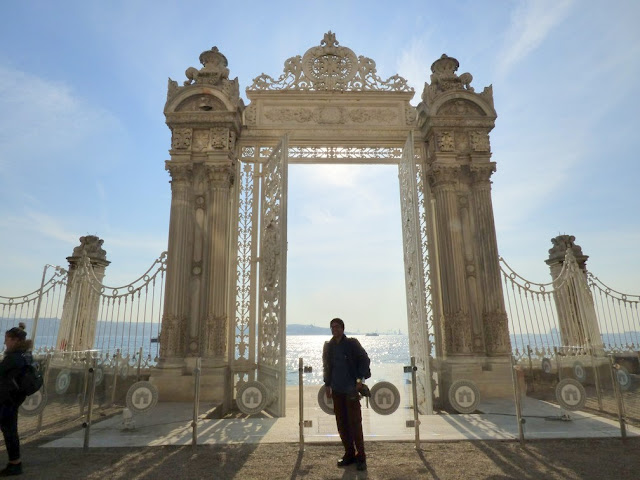
NOV 14, 2021, SUNDAY:
Dolmabahçe Palace (Turkish: Dolmabahçe Sarayı, ) 9-4; Monday closed. So we decided to visit it on Sunday. Took tram T1 to the terminal Kabatas and walked to the palace.
Dolmabahçe palace did not accept the museum card and ENTRY WAS 150 liras, there was additional 60 liras on top of that for the Paintings. Nice palace marred by over aggressive docents who kept yelling at visitors for daring to take a pic with their phones.
Located in the Beşiktaş district of Istanbul, Turkey, on the European coast of the Bosporus strait, it served as the main administrative center of the Ottoman Empire from 1856 to 1887 and from 1909 to 1922 (Yıldız Palace was used in the interim period).
The site of Dolmabahçe was originally a bay on the Bosporus which was used for the anchorage of the Ottoman fleet. The area was reclaimed gradually during the 18th century to become an imperial garden, much appreciated by the Ottoman sultans; it is from this garden that the name Dolmabahçe (Filled-in Garden) comes from the Turkish dolma meaning "filled" and bahçe meaning "garden." Various small summer palaces and wooden pavilions were built here during the 18th and 19th centuries ultimately forming a palace complex named Beşiktaş Waterfront Palace. The area of 110,000 m² is confined by Bosporus on the east side, while a steep precipice bounds it on the west side, such that after the building of the new 45,000 m² monoblock Dolmabahçe Palace a relatively limited space has remained for a garden complex which would normally surround such a palace
Dolmabahçe is the largest palace in Turkey. It has an area of 45,000 m2 (11.1 acres), and contains 285 rooms, 46 halls, 6 baths (hamam) and 68 toilets.
The design contains eclectic elements from the Baroque, Rococo and Neoclassical styles, blended with traditional Ottoman architecture to create a new synthesis
Built between the years 1843 and 1856 by the Empire's 31st Sultan, Abdülmecid . Previously, the Sultan and his family had lived at the Topkapı Palace, but as the medieval Topkapı was lacking in contemporary style, luxury, and comfort, as compared to the palaces of the European monarchs, Abdülmecid decided to build a new modern palace near the site of the former Beşiktaş Sahil Palace, which was demolished
Cost five million Ottoman gold lira, or 35 tonnes of gold, the equivalent of ca. $1.9 billion in today's (2021) values. This sum corresponded to approximately a quarter of the yearly tax revenue. Actually, the construction was financed through debasement, by massive issue of paper money, as well as by foreign loans. The huge expenses placed an enormous burden on the state purse and contributed to the deteriorating financial situation of the Ottoman Empire, which eventually defaulted on its public debt in October 1875,
The palace was home to six Sultans from 1856, when it was first inhabited, up until the abolition of the Caliphate in 1924: The last royal to live here was Caliph Abdülmecid Efendi. A law that went into effect on March 3, 1924 transferred the ownership of the palace to the national heritage of the new Turkish Republic. Mustafa Kemal Atatürk, the founder and first President of the Republic of Turkey, used the palace as a presidential residence during the summers













































Functionally, on the other hand, the
palace retains elements of traditional Ottoman palace life, and also
features of traditional Turkish homes. It is strictly separated
structurally in a southern wing (Mabeyn-i Hümâyûn, or Selamlık,
the quarters reserved for the men) which contains the public
representation rooms, and a northern wing (Harem-i Hümâyûn,
the Harem) serving as the private residential area for the
Sultan and his family. The two functional areas are separated by the
big Ceremonial Hall (Muayede Salonu) with a floor area of
2,000 m2 (22,000 sq ft) and a 36 m (118 ft)
high dome. Since the harem had to be completely isolated from the
outside world, the main entrance for the visitors is located on the
narrow southern side. There, the representation rooms are arranged
for receptions of visitors and of foreign diplomats. The harem area
includes eight interconnected apartments for the wives of the sultan,
for his favourites and concubines, and for his mother, each with its
own bathroom.
Whereas the Topkapı Palace has
exquisite examples of Iznik tiles and Ottoman carving, the
Dolmabahçe palace is extensively decorated with gold and crystal.
Fourteen tonnes of gold were used to gild the ceilings.
The world's largest Bohemian
crystal chandelier is in the Ceremonial Hall. The
chandelier was assumed to be a gift from Queen Victoria, however
in 2006 the receipt was found showing it was paid for in full. It has
750 lamps and weighs 4.5 tonnes.
Dolmabahçe has the largest collection
of Bohemian and Baccarat crystal chandeliers in the world.
The famous Crystal Staircase has the shape of a
double horseshoe and is built of Baccarat
crystal, brass and mahogany.
Expensive stones such
as Marmara (Proconnesian) marble,
Egyptian alabaster (calcite, also known as onyx-marble),
and Porphyry from Pergamon were used for the
decoration.
The palace includes a large number
of Hereke palace carpets made by the Hereke Imperial
Factory. Also featured are 150-year-old bearskin rugs originally
presented to the Sultan as a gift by Tsar Nicholas I.
A collection of 202 oil paintings is on
display in the palace. A highlight of the collection are 23 paintings
by Ivan Aivazovsky which he created as a court painter
highest technical standards. Gas
lighting and water-closets were imported from Great
Britain, whereas the palaces in continental Europe were still lacking
these features at that time. Later, electricity, a central
heating system and an elevator were installed.












































































































































After touring the main palace and the harem, we came to the grounds.
Report continues


















































































































































































































No comments:
Post a Comment